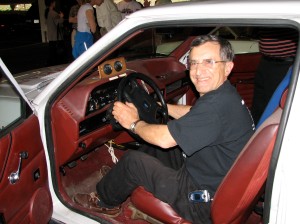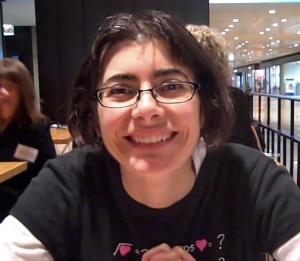Yesterday when I got home from school, I caught the train into the city and met up with my husband. We had dinner at Sang Kee Noodle House and then took a taxi to The Franklin Institute in Philadelphia, which was hosting the New Frontiers in Astronomy and Cosmology program, a celebration in honor of John Templeton (born in 1912) and marking the 40th anniversary of the establishment of the Templeton Prize and the 25th anniversary of the establishment of the John Templeton Foundation.
I might have ignored this event, but the star attraction was the lecture by Brian Greene, author of The Elegant Universe, The Fabric of the Cosmos, and The Hidden Reality. I’m a fan of the NOVA series based on the first two books, and I have showed them to my students. Greene has also been on a couple of awesome RadioLab podcasts, The (Multi) Universe(s) and DIY Universe. So I convinced Greg we should go, and wrote in for free tickets.
The e-mail I got back said that the lecture was over-subscribed (the conference organizers had no idea that Greene was so popular?) so we arrived early to stand in line and get a seat. It was worth it. Before hand we chatted with a colleague and his students, and found out that one of his students had worked with one of my students over the summer. That student of mine was there with his brother and parents, and then I saw two others of my students there also! In fact, I got a photo of one with Greene!
This particular student plans to be a physicist when he grows up, and dreams of discovering a previously unknown law of physics.
After the talk, Greene answered a few questions. I asked if it was possible to observationally determine if there were in fact other universes outside of our own. The short answer is yes, IF another bubble universe bumped up with ours we should be able to observe the resulting “ripples” in the cosmic microwave background radiation.
Then, there was a panel discussion featuring
- Marcelo Gleiser of Dartmouth, who is interested in the origin of life on Earth and elsewhere in the universe
- Geoffrey Marcy of UC Berkeley, who is a co-investigator on the Kepler extra-solar planet finding team
- David M. Spergel of Princeton, who works with the data from the WMAP satellite, which distinguished fine fluctuations in the cosmic microwave background
- Alexander Vilenkin of Tufts, who has developed the idea of the multiverse and works on inflation and cosmic strings.
Wow. What a collection of thinkers! They were given the questions
I. What was the earliest state of the universe?
II. Is our universe unique or is it part of a much larger multiverse?
III. What is the origin of the complexity in the universe?
IV. Are we alone in the universe? Or, are there other life and intelligence beyond the solar system?
and this is what the discussion centered on. Then they took questions. Partway through, Marcy commented that he was surprised that the audience seemed much more interested in the idea of the multiverse than with the idea of aliens from other planets.
Other interesting tidbits: we were seated right behind 97-year-old Nobel Laureate Charles Townes, who invented the precursor to the LASER (the MASER, which stands for Microwave Amplification by Stimulated Emission of Radiation) and who is also a Templeton Prize recipient. According to Wikipedia, Townes is the only figure other than Mother Teresa and the Dalai Lama to win both a Templeton Prize and a Nobel Prize. The conference organizer was Donald York, one of the Principal Investigators on the Sloan Digital Sky Survey, a project for mapping all the galaxies in the visible universe. I have had my students use the data for projects through the Sky Server website. The data released is so comprehensive, a dedicated middle-schooler or high-schooler could ask a question and do research that could be eligible for journal publication. Finally, the panel moderator was George Ellis, also a Templeton Prize winner, who is a pre-eminent researcher in cosmology and general relativity, and who has co-authored a book with Stephen Hawking. The only way this evening could have been more exciting would be if Kip Thorne or Stephen Hawking had been there too. It was awe-inspiring to be in the same room with these people!








